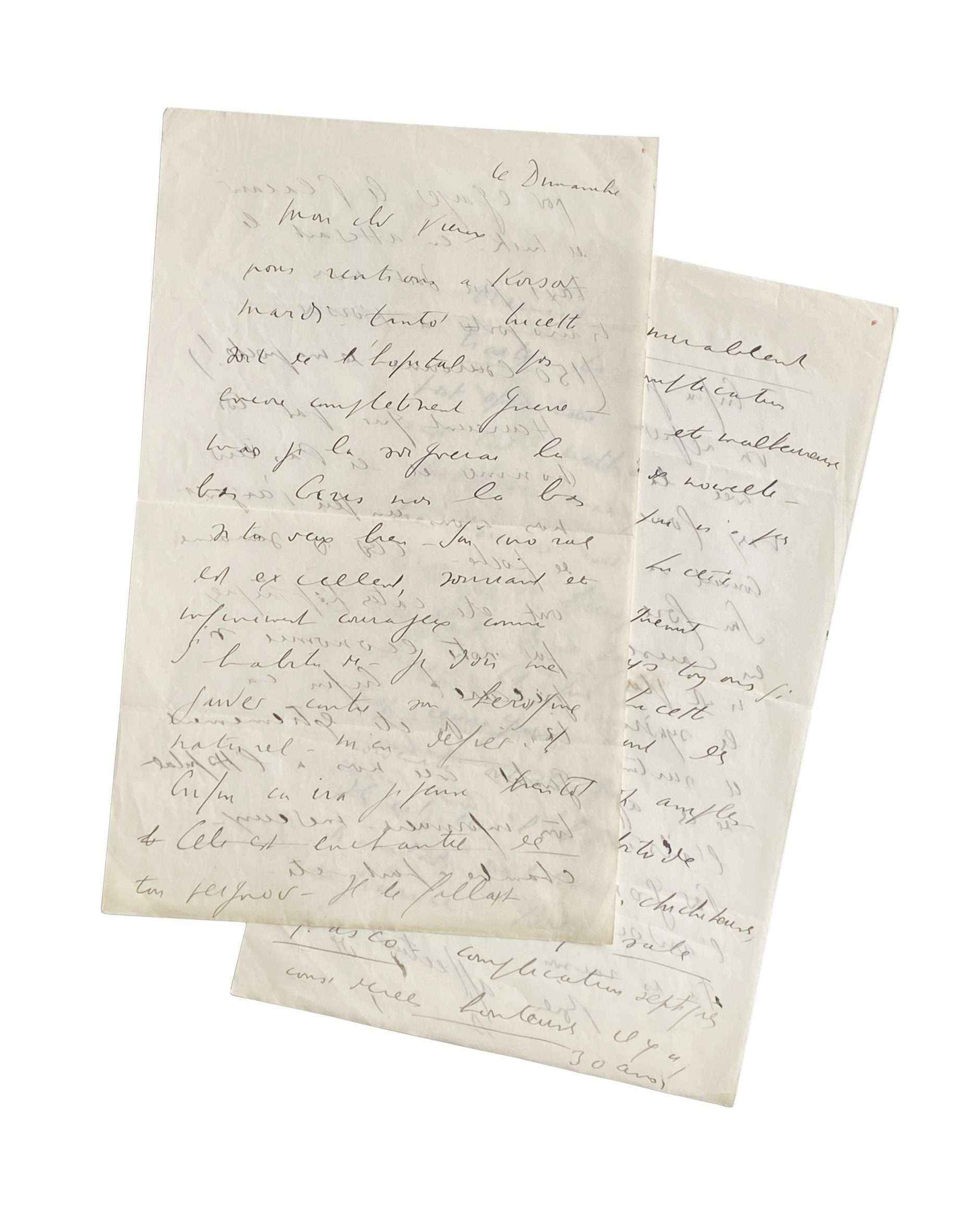CÉLINE, Louis-Ferdinand (1894-1961)
Autograph letter signed « LF » to Jean-Gabriel Daragnès
N.p, [Danemark], « le Dimanche » [25th June 1950], 4 p. in-folio
« I think we’re going to get back on a lease with life »
Fact sheet
CÉLINE, Louis-Ferdinand (1894-1961)
Autograph letter signed « LF » to Jean-Gabriel Daragnès
N.p, [Danemark], « le Dimanche » [25th June 1950], 4 p. in-folio
Usual fold marks from period, tiny red top on top right corners (see scan)
Céline gives news of Lucette after a post-operative complication and then ends his letter by delivering medical recommendations for his friend’s wife
« Mon cher Vieux,
Nous rentrons à Korsør mardi tantôt1 – Lucette sort de l’hôpital pas encore complètement guérie – mais je la soignerai là-bas. Écris-moi là-bas si tu veux bien. Son moral est excellent, souriant et infiniment courageux comme d’habitude. Je dois me garder contre son héroïsme naturel, m’en défier ! Enfin ça ira je pense bientôt. Elle est enchantée de ton peignoir. Il le fallait pour égayer le placard de Mik[kelsen] en attendant le taxi qui doit nous transporter à Korsør (150 couronnes de ma poche !) Heureusement que par toi Monnier et le Pasteur [François Löchen] nous avons un peu d’argent de poche. Ces 6 semaines ont été catastrophiques pour notre économie si précaire ! Enfin ça ira. On [a] été extrêmement gentil avec nous à l’hôpital tous infirmières – médecins – chambre à part, etc. Vraiment adorablement traités. La complication post-opératoire a été malheureuse c’est tout – méthode nouvelle – justifiée – mais qui n’a pas bien tourné avec Lucette. Le temps ! brusquement étouffant, dans ce pays toujours si froid. Et puis Lucette trop courageuse dont les mouvements ont été trop amples. Ils ont ici l’habitude des malades ratatinés, chichiteuses, engourdies. Bref sale fiasco, complications septiques considérées honteuses il y a 30 ans.
Enfin je crois qu’on va reprendre un bail avec la vie. Je vais foncer au manuscrit [Céline était alors en pleine écriture de Féerie pour une autre fois II] Comment va ta femme ? Son foie est sûrement en cause2 – Mais rien n’est plus complexe que les syndromes hépatiques et surtout les traitements de ces affections. D’abord l’abstinence de tout totale pour gommer effacer l’ardoise – y voir clair. Tuas raison.
Bien affectueusement à vous deux.
LF »
1- The return to Korsør took place on Tuesday 27 June, a date confirmed by his letter to Marie Canavaggia on 1 July. The preceding Sunday, as indicated at the head of the letter, can therefore only be June 25.
2- In another unpublished letter from the same period, Céline gives advice on food hygiene to Daragnès, which is therefore also intended for his wife. However, it was Jean-Gabriel Daragnès who, a month later, on July 25, 1950, died following surgery.
A friend and unwavering supporter of Céline during the dark years, the engraver and printer Jean-Gabriel Daragnès (1886-1950) settled in Montmartre in the mid-1920s on Avenue Junot. He met Céline through Gen-Paul and Marcel Aymé, but did not become friends with him until later, when the author of Voyage au bout de la nuit treated his mother, who was seriously ill, as a doctor. Daragnès was one of the first to whom Céline wrote after her incarceration in Denmark. He thus became his trusted man in France, his informant in Montmartre, his intermediary with publishers, and even agreed in 1949 to act personally with the Court of Justice on his behalf. Daragnès came to Denmark twice, in 1948, as curator of the exhibition of French books in Copenhagen, and did not fail to visit the exile at that time. When he died suddenly in 1950 following an operation, Céline lost one of her strongest supports. In an intermediate version of his novel Féerie pour une autre fois, written in Denmark, he presents him as “the greatest engraver of France”.
Provenance:
Vente d’autographes, Drouot, 5 juin 1992, Frédéric Castaing expert, n°42
Patrice Campesato’s estate
Bibliography:
Quinze lettres, éd. Henri Godard, Du Lérot, 1984, p. 29-30
Lettres, éd. Henri Godard et Jean-Paul Louis, Pléiade, 2009, n°50-68
